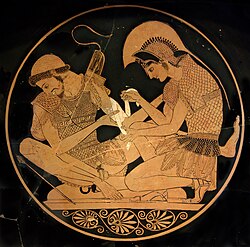This article needs additional citations for verification .(November 2021) |




A bandage is a piece of material used either to support a medical device such as a dressing or splint, or on its own to provide support for the movement of a part of the body. When used with a dressing, the dressing is applied directly on a wound, and a bandage is used to hold the dressing in place. Other bandages are used without dressings, such as elastic bandages, which are used to reduce swellings or to provide support to a sprained joint. Tight bandages can be used to slow blood flow to an extremity, such as when a leg or arm is bleeding heavily.
Contents
- Types
- Gauze bandage
- Adhesive bandage
- Liquid bandage
- Compression bandage
- Triangular bandage
- Tube bandage
- Kirigami bandage
- See also
- References
- External links
Bandages are available in a wide range of types, from generic cloth strips to specially shaped bandages designed for a specific limb or part of the body. Bandages can often be improvised as the situation demands, using clothing, blankets or other material. In American English, the word bandage is often used to indicate a small gauze dressing attached to an adhesive bandage.

